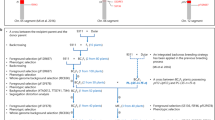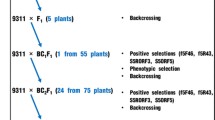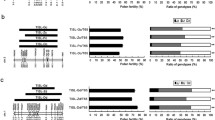Abstract
Hybrid sterility is a major obstacle to the development of superior inter-subspecific hybrids between indica and japonica subspecies of Asian-cultivated rice. To overcome hybrid sterility, we introduced four japonica alleles (S-j) at Sa, Sc, f5, and S32 loci from Nipponbare into 9311 through marker-assisted backcross breeding, and four improved lines were obtained. Three wide-compatibility lines 9311(S5-n), 9311(f5-n), and 9311(S5-n+f5-n) previously constructed were used as control and parental line of hybridization. By crossing with 9311(S5-n+f5-n), two pyramiding lines 9311(Sa+S5-n+f5-n) and 9311(S32+Sa+S5-n+f5-n) were obtained. To evaluate the gene effect of pollen fertility and spikelet fertility, the near-isogenic lines (NILs) harboring S5-n, f5-n, Sa, Sc, f5, or S32 and three pyramiding lines with S5-n+f5-n, Sa+S5-n+f5-n, or S32+Sa+S5-n+f5-n were testcrossed to six japonica varieties. The results showed that single-gene f5, f5-n, S32, and S5-n could significantly improve spikelet fertility in majority of indica-japonica hybrids. Single-gene Sa and Sc could significantly improve spikelet fertility in part of indica-japonica hybrids. Moreover, the pyramiding lines exhibited significantly higher spikelet fertility than the control in indica-japonica hybrids. A significant increase in spikelet fertility (31.4–55%) was observed in three- or four-gene pyramiding lines. Our results provide an effective approach to exploiting heterosis between indica and japonica subspecies, which had a profound implication in rice breeding.





Similar content being viewed by others
Data availability
The data sets supporting the results of this article are included within the article and its additional files.
References
Chakraborty S (2001) Rice breeding and genetics. New Delhi, India
Chen J, Ding J, Ouyang Y, Du H, Yang J, Cheng K, Zhao J, Qiu S, Zhang X, Yao J, Liu K, Wang L, Xu C, Li X, Xue Y, Xia M, Ji Q, Lu J, Xu M, Zhang Q (2008) A triallelic system of S5 is a major regulator of the reproductive barrier and compatibility of indica–japonica hybrids in rice. Proc Natl Acad Sci U S A 105:11436–11441
Chen L, Zhao Z, Liu X, Liu L, Jiang L, Liu S, Zhang W, Wang Y, Liu Y, Wan J (2011) Marker-assisted breeding of a photoperiodsensitive male sterile japonica rice with high cross-compatibility with indica rice. Mol Breed 27:247–258
Chen H, Xie W, He H, Yu H, Chen W, Li J, Yu R, Yao Y, Zhang W, He Y, Tang X, Zhou F, Deng X, Zhang Q (2014) A high-density SNP genotyping array for rice biology and molecular breeding. Mol Plant 7:541–553
Fan M, Shen J, Yuan L, Jiang R, Chen X, Davies W, Zhang F (2011) Improving crop productivity and resource use efficiency to ensure food security and environmental quality in China. J Exp Bot 63(1):13–24
Gu M, Pan X, Chen Z, Yang W (1991) A study on compatibility of standard wide compatibility testers of rice in China (in Chinese with English abstract). Sci Agric Sin 24:27–32
Guo J, Xu X, Li W, Zhu W, Zhu H, Liu Z, Luan X, Dai Z, Liu G, Zhang Z, Zeng R, Tang G, Fu X, Wang S, Zhang G (2016) Overcoming inter-subspecific hybrid sterility in rice by developing indica-compatible japonica lines. Sci Rep 6:26878–26878
Ikehashi H, Araki H (1984) Variety screening of compatibility types revealed in F1 fertility of distant crosses in rice. Jpn J Breed 34:304–313
Ikehashi H, Araki H (1986) Genetics of F1 sterility in remote crosses of rice. In: IRRI (ed) Rice genetics. IRRI, Malina, pp 119–130
Jeon J, Jung K, Kim H, Suh J, Khush G (2011) Genetic and molecular insights into the enhancement of rice yield potential. J Plant Biol 54:1–9
Jiang H, Feng Y, Bao L, Li X, Gao G, Zhang Q, Xiao J, Xu C, He Y (2012) Improving blast resistance of Jin 23B and its hybrid rice by marker-assisted gene pyramiding. Mol Breed 30(4):1679–1688
Jiang H, Hu J, Li Z, Gao G, Zhang Q, Xiao J, He Y (2018) Evaluation and breeding application of six brown planthopper resistance genes in rice maintainer line Jin 23B. Rice 11:22
Jiang H, Li Z, Liu J, Shen Z, Gao G, Zhang Q, He Y (2019) Development and evaluation of improved lines with broad-spectrum resistance to rice blast using nine resistance genes. Rice 12:29
Khanna A, Sharma V, Ellur RK, Shikari AB, Gopala Krishnan S, Singh UD, Prakash G, Sharma TR, Rathour R, Variar M, Prashanthi SK, Nagarajan M, Vinod KK, Bhowmick PK, Singh NK, Prabhu KV, Singh BD, Singh AK (2015) Development and evaluation of near-isogenic lines for major blast resistance gene(s) in Basmati rice. Theor Appl Genet 128:1243–1259
Khush GS (2005) What it will take to feed 5.0 billion rice consumers in 2030. Plant Mol Biol 59:1–6
Koide Y, Ogino A, Yoshikawa T, Kitashima Y, Saito N, Kanaoka Y, Onishi K, Yoshitake Y, Tsukiyama T, Saito H, Teraishi M, Yamagata Y, Uemura A, Takagi H, Hayashi Y, Abe T, Fukuta Y, Okumoto Y, Kanazawa A (2018) Lineage-specific gene acquisition or loss is involved in interspecific hybrid sterility in rice. Proc Natl Acad Sci U S A 115(9):E1955–E1962
Kubo T, Takashi T, Ashikari M, Yoshimura A, Kurata N (2016) Two tightly linked genes at the hsa1 locus cause both F1 and F2 hybrid sterility in rice. Mol Plant 9:221–232
Li H, Wang J, Liu A, Liu K, Zhang Q, Zou J (1997) Genetic basis of low-temperature-sensitive sterility in indica–japonica hybrids of rice as determined by RFLP analysis. Theor Appl Genet 95:1092–1097
Li D, Chen L, Jiang L, Zhu S, Zhao Z, Liu S, Su N, Zhai H, Ikehashi H, Wan J (2007) Fine mapping of S32(t), a new gene causing hybrid embryo sac sterility in a Chinese landrace rice (Oryza sativa L.). Theor Appl Genet 114(3):515–524
Li W, Zeng R, Zhang Z, Ding X, Zhang G (2008) Identification and fine mapping of S-d, a new locus conferring the partial pollen sterility of intersubspecific F1 hybrids in rice (Oryza sativa L.). Theor Appl Genet 116:915–922
Lin J, Song X, Wu M (2012) Biological characteristics and heterosis utilization of four indica–japonica intermediate type restorer lines with wide compatibility. Chin J Rice Sci 26:656–662
Liu Y, Sun J, Zhou K (1997) Cytological basis causing spikelet sterility of intersubspecific hybrid in Oryza sativa (in Chinese with English abstract). Acta Biol Exp Sin 30:335–341
Liu H, Xu C, Zhang Q (2004) Male and female gamete abortions, and reduced affinity between the uniting gametes as the causes for sterility in an indica/japonica hybrid in rice. Sex Plant Reprod 17:55–62
Long Y, Zhao L, Niu B, Su J, Wu H, Chen Y, Zhang Q, Guo J, Zhuang C, Mei M, Xia J, Wang L, Wu H, Liu Y (2008) Hybrid male sterility in rice controlled by interaction between divergent alleles of two adjacent genes. Proc Natl Acad Sci U S A 105:18871–18876
Lu Y, Ma R, Wang X, Li X, Zhou H, Zhang Z, Hua G (2007) SSLP-based SSR fingerprinting and indica/japonica classification of Yongyou series hybrid rice (in Chinese with English abstract). Chin J Rice Sci 21:443–446
Maekawa M, Inukai T, Shinbashi N (1997) Genic analysis of hybrid sterility caused by anther indehiscence between distantly related rice varieties. Euphytica 94:311–318
Mi J, Li G, Huang J, Yu H, Zhou F, Zhang Q, Ouyang Y, Mou T (2016) Stacking S5-n and f5-n to overcome sterility in indica–japonica hybrid rice. Theor Appl Genet 129:563–575
Mi J, Lei Y, Kim SY, Prahalada GD, Ouyang Y, Mou T (2019) An effective strategy for fertility improvement of indica-japonica hybrid rice by pyramiding S5-n, f5-n, and pf12-j. Mol Breed 39:138
Mizuta Y, Harushima Y, Kurata N (2010) Rice pollen hybrid incompatibility caused by reciprocal gene loss of duplicated genes. Proc Natl Acad Sci U S A 107:20417–20422
Nguyen G, Yamagata Y, Shigematsu Y, Watanabe M, Miyazaki Y, Doi K, Tashiro K, Kuhara S, Kanamori H, Wu J, Matsumoto T, Yasui H, Yoshimura A (2017) Duplication and loss of function of genes encoding RNA polymerase III subunit C4 causes hybrid incompatibility in rice. G3 Bethesda 7:2565–2575
Ouyang Y (2016) Progress of indica-japonica hybrid sterility and wide-compatibility in rice. Chin Sci Bull 61:3833–3841
Ouyang Y, Chen J, Ding J, Zhang Q (2009) Advances in the understanding of inter-subspecific hybrid sterility and wide-compatibility in rice. Chin Sci Bull 54:2332–2341
Ouyang Y, Liu Y, Zhang Q (2010) Hybrid sterility in plant: stories from rice. Curr Opin Plant Biol 13:186–192
Shen R, Wang L, Liu X, Wu J, Jin W, Zhao X, Xie X, Zhu Q, Tang H, Li Q, Chen L, Liu Y (2017) Genomic structural variation-mediated allelic suppression causes hybrid male sterility in rice. Nat Commun 8:1310
Siddiq EA, Singh S (2005) Wide-compatibility system for yield enhancement of tropical rice through inter-subspecific hybridization. Adv Agron 87:157–209
Wang J, Liu K, Xu C, Li X, Zhang Q (1998) The high level of wide compatibility of variety ‘Dular’ has a complex genetic basis. Theor Appl Genet 97:407–412
Wang G, He Y, Xu C, Zhang Q (2006) Fine mapping of f5-Du, a gene conferring wide-compatibility for pollen fertility in intersubspecific hybrids of rice (Oryza sativa L.). Theor Appl Genet 112:382–387
Xie Y, Niu B, Long Y, Li G, Tang J, Zhang Y, Ren D, Liu YG, Chen L (2017a) Suppression or knockout of SaF/SaM overcomes the Sa-mediated hybrid male sterility in rice. J Integr Plant Biol 59:669–679
Xie Y, Xu P, Huang J, Ma S, Xie X, Tao D, Chen L, Liu YG (2017b) Interspecific hybrid sterility in rice is mediated by OgTPR1 at the S1 locus encoding a peptidase-like protein. Mol Plant 10:1137–1140
Xie Y, Shen R, Chen L, Liu Y (2019a) Molecular mechanisms of hybrid sterility in rice. Sci China Life Sci 62(6):737–743
Xie Y, Tang J, Xie X, Li X, Huang J, Fei Y, Han J, Chen S, Tang H, Zhao X, Tao D, Xu P, Liu Y, Chen L (2019b) An asymmetric allelic interaction drives allele transmission bias in interspecific rice hybrids. Nat Commun 10:2051
Yamagata Y, Yamamoto E, Aya K, Win KT, Doi K, Sobrizal IT, Kanamori H, Wu J, Matsumoto T, Matsuoka M, Ashikari M, Yoshimura A (2010) Mitochondrial gene in the nuclear genome induces reproductive barrier in rice. Proc Natl Acad Sci U S A 107:1494–1499
Yang C, Chen Z, Zhuang C, Mei M, Liu Y (2004) Genetic and physical fine-mapping of the Sc locus conferring indica-japonica hybrid sterility in rice (Oryza sativa L.). Chin Sci Bull 16:1718–1721
Yang J, Zhao X, Cheng K, Du H, Ouyang Y, Chen J, Qiu S, Huang J, Jiang Y, Jiang L, Ding J, Wang J, Xu C, Li X, Zhang Q (2012) A killer-protector system regulates both hybrid sterility and segregation distortion in rice. Science 337:1336–1340
Yu H (2011) Cloning of rice hybrid fertility gene f5, and development and application of high-throughput molecular marker technologies (in Chinese with English abstract). Unpublished PhD dissertation, Huazhong Agricultural University
Yu H, Xie W, Li J, Zhou F, Zhang Q (2014) A whole-genome SNP array (RICE6K) for genomic breeding in rice. Plant Biotechnol J 12:28–37
Yu Y, Zhao Z, Shi Y, Tian H, Liu L, Bian X, Xu Y, Zheng X, Gan L, Shen Y, Wang C, Yu X, Wang C, Zhang X, Guo X, Wang J, Ikehashi H, Jiang L, Wan J (2016) Hybrid sterility in rice (Oryza sativa L.) involves the tetratricopeptide repeat domain containing protein. Genetics 203:1439–1451
Yu X, Zhao Z, Zheng X, Zhou J, Kong W, Wang P, Bai W, Zheng H, Zhang H, Li J, Liu J, Wang Q, Zhang L, Liu K, Yu Y, Guo X, Wang J, Lin Q, Wu F, Ren Y, Zhu S, Zhang X, Cheng Z, Lei C, Liu S, Liu X, Tian Y, Jiang L, Ge S, Wu C, Tao D, Wang H, Wan J (2018) A selfish genetic element confers non-Mendelian inheritance in rice. Science 360:1130–1132
Zhang G, Lu Y (1999) Breeding of the indica compatible japonica lines and their use in the breeding of super high yield hybrid rice (in Chinese with English abstract). Hybrid Rice 14:3–5
Zhang Q, Zhou Z, Yang G, Xu C, Liu K, Saghai Maroof MA (1996) Molecular marker heterozygosity and hybrid performance in indica and japonica rice. Theor Appl Genet 93:1218–1224
Zhang Z, Lu Y, Feng J, Liu X, Zhang G (2004) Studies on the anther dehiscence in F1 of hybrids between Taichung 65 and its F1 pollen sterility near isogenic lines (in Chinese with English abstract). J Trop Subtrop Bot 12:521–527
Zhang D, Luo X, Zhu L (2011) Cytological analysis and genetic control of rice anther development. J Genet Genomics 38:379–390
Zhao M, Li X, Yang J, Xu C, Hu R, Liu D, Zhang Q (1999) Relationship between molecular marker heterozygosity and hybrid performance in intra- and inter-subspecific crosses of rice. Plant Breed 118:139–144
Zhou P, Tan Y, He Y, Xu C, Zhang Q (2003) Simultaneous improvement for four quality traits of Zhenshan 97, an elite parent of hybrid rice, by molecular marker-assisted selection. Theor Appl Genet 106:326–331
Acknowledgments
We are very grateful to Professor Tongmin Mou (Huazhong Agricultural University) for providing seeds of the wide-compatibility lines. Great gratitude goes to linguistics professor Ping Liu from Foreign Language College, Huazhong Agriculture University, Wuhan, China, for her work at English editing and language polishing.
Funding
This work was supported by grants from the National Natural Science Foundation of China (31801438).
Author information
Authors and Affiliations
Contributions
HJ conceived and designed the experiments; XM, XW, and GG performed the experiments; HJ and XM analyzed the data; HJ and XM wrote the manuscript.
Corresponding author
Ethics declarations
Competing interests
The authors declare that they have no competing interests.
Ethics approval and consent to participate
Not applicable.
Consent for publication
Not applicable.
Additional information
Publisher’s note
Springer Nature remains neutral with regard to jurisdictional claims in published maps and institutional affiliations.
Electronic supplementary material
ESM 1
(DOCX 16 kb).
Rights and permissions
About this article
Cite this article
Ma, X., Wei, X., Gao, G. et al. Development and evaluation of improved lines based on an elite rice variety 9311 for overcoming hybrid sterility in rice. Mol Breeding 40, 102 (2020). https://doi.org/10.1007/s11032-020-01180-2
Received:
Accepted:
Published:
DOI: https://doi.org/10.1007/s11032-020-01180-2




